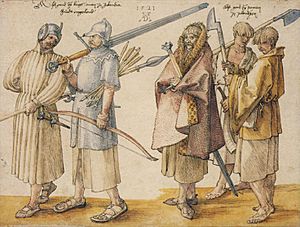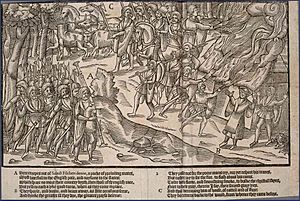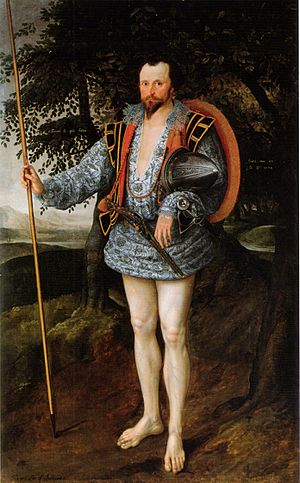Kern (soldier) facts for kids
A kern was a type of warrior from Ireland long ago. They were known for being quick and light on their feet, like light infantry soldiers. Kerns were an important part of Irish armies, especially during the Middle Ages. They were skilled fighters who used their speed and knowledge of the land to fight against larger, more heavily armed forces.
Contents
What Does "Kern" Mean?
The word 'kern' comes from an old Irish word, ceithern. This word meant a group of people, especially fighters. An individual kern was called a ceithernach. Over time, English speakers started using 'kern' to describe these Irish soldiers. Interestingly, the word ceithernach is also used today in Irish to mean a chess pawn!
How Kerns Fought

Kerns often fought alongside another type of Irish warrior called gallowglasses. Gallowglasses were mercenary soldiers who wore heavy armor and fought as heavy infantry. Kerns, on the other hand, were light infantry. This meant they didn't wear much armor, which allowed them to move very quickly.
In earlier times, kerns were like local militia soldiers. They used weapons they owned, such as swords, shields, bows, and javelins. They made up a large part of most Irish armies. Later, some Irish leaders, like Shane O'Neill and Hugh O'Neill, Earl of Tyrone, even trained their kerns to be professional soldiers. They gave them modern weapons and taught them new fighting methods.
Kerns' Equipment and Tactics
Kerns were known for their speed and ability to move easily. They often used surprise attacks, a type of guerilla warfare. This allowed them to fight against much larger groups of enemies. One writer described them as "lighter and lustier than [English soldiers) in travail and footmanship."
A common description of a kern shows them with light armor, perhaps made of leather. Their weapons included:
- A sword (called a claideamh)
- A long dagger (called a scian)
- A bow (called a bogha)
- A set of javelins or darts (called ga)
Kerns were very good at throwing their darts with amazing speed and accuracy. These darts were especially dangerous to enemy horsemen. Kerns were also quick to learn new fighting styles and weapons from other parts of Europe. They started using firearms, but they still kept their traditional weapons. They used these older weapons effectively in places where modern tactics didn't work as well, like in forests.
Woodkerns: Forest Fighters
Some Irish people were forced to leave their homes after the Anglo-Norman invasion. These displaced people sometimes became bandits living in the forests of Ireland. They were known as "wood kerns" or cethern coille. They were such a problem for new settlers that a law was passed in 1297. This law required forest owners to clear trees from roads. This made it harder for wood kerns to hide and launch attacks.
Kerns in Famous Stories
Kerns are mentioned in plays by the famous writer William Shakespeare.
In his play Henry IV, Part 2 (written in 1599), a character talks about kerns:
Cardinal.
My Lord of York, try what your fortune is.
The uncivil kerns of Ireland are in arms,
And temper clay with blood of Englishmen.
To Ireland will you lead a band of men,
Collected choicely, from each county some,
And try your hap against the Irishmen?
Shakespeare also mentions kerns in his play Macbeth (written in 1606):
The merciless Macdonwald,
Worthy to be a rebel, for to that
The multiplying villainies of nature
Do swarm upon him, from the Western isles
Of kerns and gallowglasses is supplied
See Also
- Fianna



